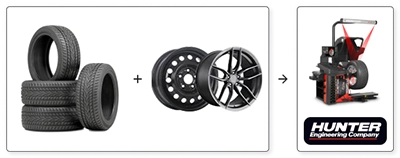What is the difference between a studded tire and a studdable tire?

Every fall, Canadians rush to buy new winter tires or have their old ones installed from previous years when the temperatures drop, and the snow begins to fall.
Many Canadians know the dangers of winter on icy or snowy roads and have winter tires installed on their vehicles.
Winter tires are designed to improve grip and handling by keeping the rubber more flexible in cold weather.
They also offer increased stability during acceleration and shorter stopping distances on snow or ice.
If you've done any research on winter tires, you may have noticed that there are several types:
- Winter tires
- Winter tires that may have studs (nails)
- Factory studded winter tires
We will explore the differences between the last two categories, factory studded winter tires and tires that can be studded.
First, let's define what studs are, or if you prefer, nails.
Studs are small round pieces of metal, rubber or plastic that dig into the ground to provide better traction, primarily for ice driving.
You can also find studded winter tires made of hard rubber, but the majority of studded winter tires on the market are made of metal.
Studdable Winter Tires
Studded winter tires are a hybrid option between studless and studded tires. Studs can be screwed into pre-drilled holes in the tread of these tires. When studs are added, these tires provide excellent traction on snowy and icy roads to ensure greater safety.
Why use studdable winter tires?
Studdable winter tires are designed for driving in snow and ice. They increase traction in all winter road conditions.
A studded tire is ideal for drivers who live in areas with both extreme and moderate winter conditions, such as all Canadian provinces and territories.
How to identify studdable winter tires
When the studs are not in place, a studdable tire is easily identified by the molded sockets, into which the optional studs can be screwed. The tread of a studdable tire is similar to that of a studless winter tire, except for the holes for inserting the studs.
Advantages of studdable winter tires
One of the most obvious advantages of a studded tire is that you get the best of studded and studless winter tires. They are very aggressive and especially effective on ice, steep slopes, and compacted snow.
The great thing about these tires is that they increase driver confidence.
Disadvantages of studdable winter tires
The only real disadvantage of a studdable tire is the inconvenience of adding studs to the tires. This can be time-consuming, as each stud must be individually mounted in the tire's holes. There are usually between 80 and 100 studs on each tire.
Studded Winter Tires
Studded winter tires are built at the manufacturers with small studs (the studs), which are permanent parts of the tread. They are ideal for driving on ice and deep snow because these studs grip the road for better traction, similar to how football shoe studs dig into the turf.
The factory molding of a tread with studs is more masterful, and the studs are more sophisticated. Some manufacturers use specific metals, such as tungsten, and more elaborately shaped studs to reduce road noise.
"Although tire studding technology has improved in recent years, it is best to choose a factory studded tire," advises CAA.
A factory studded tire is usually sold at a slightly higher price, but you can have peace of mind knowing that when you buy a factory studded tire, it has the right size studs and is properly installed.
So the pros and cons of studded tires depend on your lifestyle and driving habits.
The best studded tires are the Michelin X-ICE NORTH 4, the Continental IceContact XTRM, the Pirelli Winter Ice Zero studded, the Toyo Observe G3 Ice Studded and the Hankook Winter i*pike RS2 (W429) Studded.


